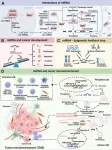(Press-News.org) Although all ecosystems are affected by a changing climate, the impacts can take a while to appear. Changes in forest biodiversity, for example, are known to lag behind changes in a habitat's temperature and precipitation.
Grasslands, on the other hand, are responding to climate change almost in real time, according to new research by the University of Michigan. Put another way, forests accumulate climate debt while grasslands are paying as they go, said the study's lead authors, Kai Zhu and Yiluan Song.
"Climate change does have consequences for our ecosystems. It's going to come sooner or later," said Song, a postdoctoral fellow at the Michigan Institute for Data and AI in Society. "Grasslands are at the faster end of the spectrum."
This work will help the scientific community better understand and predict the impacts of climate change, said Zhu, associate professor at the U-M School for Environment and Sustainability. The work will also provide key insights for the restoration of grassland vegetation.
"If you want to restore grasslands, you have to ask what types of species you will plant," Zhu said. "In order to answer that, you need to at least take climate change into consideration."
The research team reported its findings in the journal Nature Ecology & Evolution.
The team, made up of researchers from more than a dozen institutions, amassed data from years of observations across grassland communities located in what's known as the California Floristic Province.
Within this biodiversity hotspot that stretches along the U.S. West Coast, the team documented trends for 12 sites observed over decades. The researchers found that, as the climate in the region became hotter and drier, species that preferred those kinds of conditions became more dominant in plant communities.
The team also included results from long-term global change experiments in the region, enabling the group to show that climate change is able to drive the changes in communities.
"We know correlation doesn't imply causation," Zhu said. "But the experimental data allow us to attribute the causality."
The team characterized the climate preferences or niches for various species in the region. The researchers could then quantify shifts in plant communities in direct relation to temperature and precipitation changes.
This approach yielded a clear, consistent conclusion across the studied observational and experimental sites, which Zhu and Song said is uncommon for an ecological study like this.
But what stood out even more was the pace of the ecological change, they said. It was fast and comparable to the observed rate of changes in climate. And the researchers stressed that this rapid shift in plant communities should not be seen as adaptation—at least not without further studies.
"To me, adaptation gives a positive impression that the system is changing to counter some of the negative effects of climate change," Song said. "The rapid shifts in grassland communities involve not only the gain of some hotter, drier species but also the loss of some cooler, wetter species. These shifts might have negative consequences such as dominance by non-native species and loss of biodiversity."
Although their study focused on a single region, Zhu and Song believe the results will hold in other grasslands, provided they're interpreted in the context of a given region's climate dynamics. For example, if the climate is trending warmer and wetter, species more at home in those conditions will likely start taking over at a speed that matches the changing climate.
"I would hypothesize that we may see an even greater response to climate change in other grasslands around the world," Zhu said.
Researchers from California Polytechnic State University, Clark College, the East Bay Regional Park District, the University of Oregon, the University of Washington, the University of Western Australia and Stanford University also contributed to the study. The team also included members from several University of California institutions, including UC Berkeley, UC Davis, UC Riverside, UC Santa Barbara and UC Santa Cruz, where Zhu and Song began the project.
END
Grasslands live in the climate change fast lane
2024-10-16
ELSE PRESS RELEASES FROM THIS DATE:
Mount Sinai Doctors to present at ID Week 2024
2024-10-16
Experts in infection prevention and control at the Mount Sinai Health will present new research and insights at ID Week, the joint annual meeting of the Infectious Diseases Society of America, the Society for Healthcare Epidemiology of America, the HIV Medicine Association, the Pediatric Infectious Diseases Society, and the Society of Infectious Diseases Pharmacists in Los Angeles from October 16-19.
Mount Sinai doctors and researchers are also available for comment on breaking health news including the flu, COVID variants, HIV/AIDS, mpox, West Nile virus, measles, and fall vaccinations.
PRESENTATIONS and POSTER SESSIONS
*All abstracts and presentations ...
Rewriting the future: New molecules reversibly change with light and heat
2024-10-16
In this age of cloud storage, few people are backing up data on CD-RWs. The technology to rewrite data on compact discs was made possible by phase-change materials altered by the light and heat of lasers, though this had a limit of 1,000 rewrites. Today, scientists investigating photoswitching molecules, which change their properties when irradiated, have been finding possible applications for these materials, ranging from photopharmacology to data storage.
Osaka Metropolitan University Graduate School of Engineering student Shota Hamatani, Dr. Daichi Kitagawa, a lecturer, and Professor Seiya Kobatake synthesized aza-diarylethenes, which have nitrogen in place of carbon in a molecular structure ...
New breakthrough in quantum computing development, hybrid quantum error correction technology
2024-10-16
A major challenge in realizing quantum computers is the development of 'quantum error correction' technology. This technology offers a solution for addressing errors that occur in the qubit, the basic unit of quantum computation, and prevents them from being amplified during the computation. Without quantum error correction, it would be impossible for quantum computers to outperform classical counterparts, and thus efforts to advance this technology are ongoing worldwide.
Dr. Seung-Woo Lee's research team at the Korea ...
Unlocking the future: Information processing at the speed of light
2024-10-16
The integration of photonics into quantum computing has profound implications across various domains. As the demand for faster and more secure computational capabilities intensifies, photonic quantum computing emerges as a pivotal force, with the photonics market projected to reach USD 837.8 billion by 2025.
Harnessing the unique properties of light, photonic quantum computing revolutionizes data processing by encoding information in photons, offering unprecedented speed and efficiency for solving complex problems that traditional methods struggle to address. Photonic quantum computers can ...
A new chapter in cancer treatment: Innovative strategies and technologies of miRNA
2024-10-16
This study is led by Dr. Shiwei Duan (Department of Clinical Medicine, School of Medicine, Hangzhou City University, Hangzhou, Zhejiang, China). His team analyzed literature on miRNA, summarizing the close relationship between these small molecules and cancer. miRNA is a type of non-coding RNA that does not encode proteins, but can target more than 60% of human protein-coding genes. They play crucial roles in cell growth, differentiation, development, and apoptosis, and their dysfunction is closely linked to numerous diseases. Almost all known cancer cells have the ability to control gene expression using miRNAs, making the impact of miRNAs particularly significant ...
Silicon metasurfaces unlock broad-spectrum infrared imaging.
2024-10-16
Infrared imaging technology is crucial for advancing our understanding of the world, from exploring biological specimens to inspecting complex materials and detecting hidden patterns in physical systems. Infrared light can penetrate fog and smoke, making it invaluable for search and rescue, firefighting, and sensitive operations. Additionally, infrared imaging can enable visualising the heat emitted by objects, making it a powerful tool for night vision and security applications. While infrared cameras are valuable tools for enhanced ...
New research suggests: To get patients to accept medical AI, remind them of human biases
2024-10-16
While people are growing more accustomed to AI-driven personal assistants, customer service chatbots and even financial advisors, when it comes to healthcare, most still want it with a human touch.
Given that receiving healthcare is a deeply personal experience, it’s understandable that patients prefer it to come from, well, a person. But with AI’s vast potential to increase the quality, efficacy and efficiency of medicine, a push toward greater acceptance of artificial intelligence-driven medicine could unlock benefits ...
OIST and Partisia sign MOU to advance the research and development of multi-party computation and privacy enhancing technologies
2024-10-16
The Okinawa Institute of Science and Technology (OIST) and the Danish software company Partisia have signed a Memorandum of Understanding (MOU) to strengthen their research ties.
The primary objective of this collaboration is to advance research in Multi-Party Computation (MPC), focusing on developing innovative Privacy-Enhancing Technology solutions. By leveraging their combined knowledge and expertise, OIST and Partisia aim to deliver a global perspective on secure computation, quantum-safe cryptography, and cyber security.
OIST will contribute to the collaboration with its in-house expertise and ...
Beware of the full moon: Tropical forest mammals shy away from the moonlight
2024-10-16
A recent study using automatic wildlife cameras across three continents has shed light on how the moon's phases affect the behaviour of tropical forest mammals. Half of the species studied altered their activity levels or timing, or both, in response to the full moon. The findings suggest that even in some of the darkest places on earth - the floors of tropical forests - the moon's phases can influence animal behaviour. This impact could be even more pronounced in degraded and fragmented forests.
“Imagine playing hide-and-seek in a dark room, and then somebody lights ...
Energy-thirsty indoor vertical gardens ripe for improvement
2024-10-16
Indoor vertical gardens are gaining popularity among homeowners and restaurants, allowing them to grow microgreens year-round, but new research has identified a major drawback: their demands on energy.
A study by researchers from the Marche Polytechnic University and University of South Australia shows that while domestic vertical garden appliances can provide fresh, local produce under controlled conditions and with zero food miles, they do chew up energy.
Artificial lighting – essential for plant growth – accounted for more than 50% of the total energy costs in growing a crop of red lettuce, which is five times higher than professional ...






